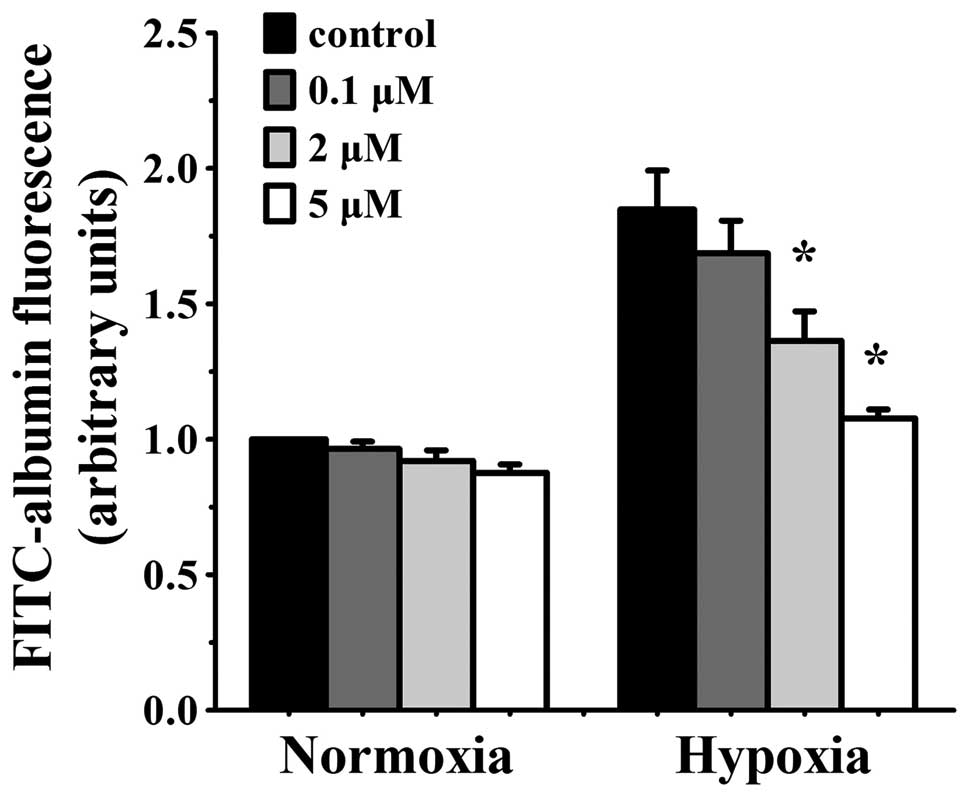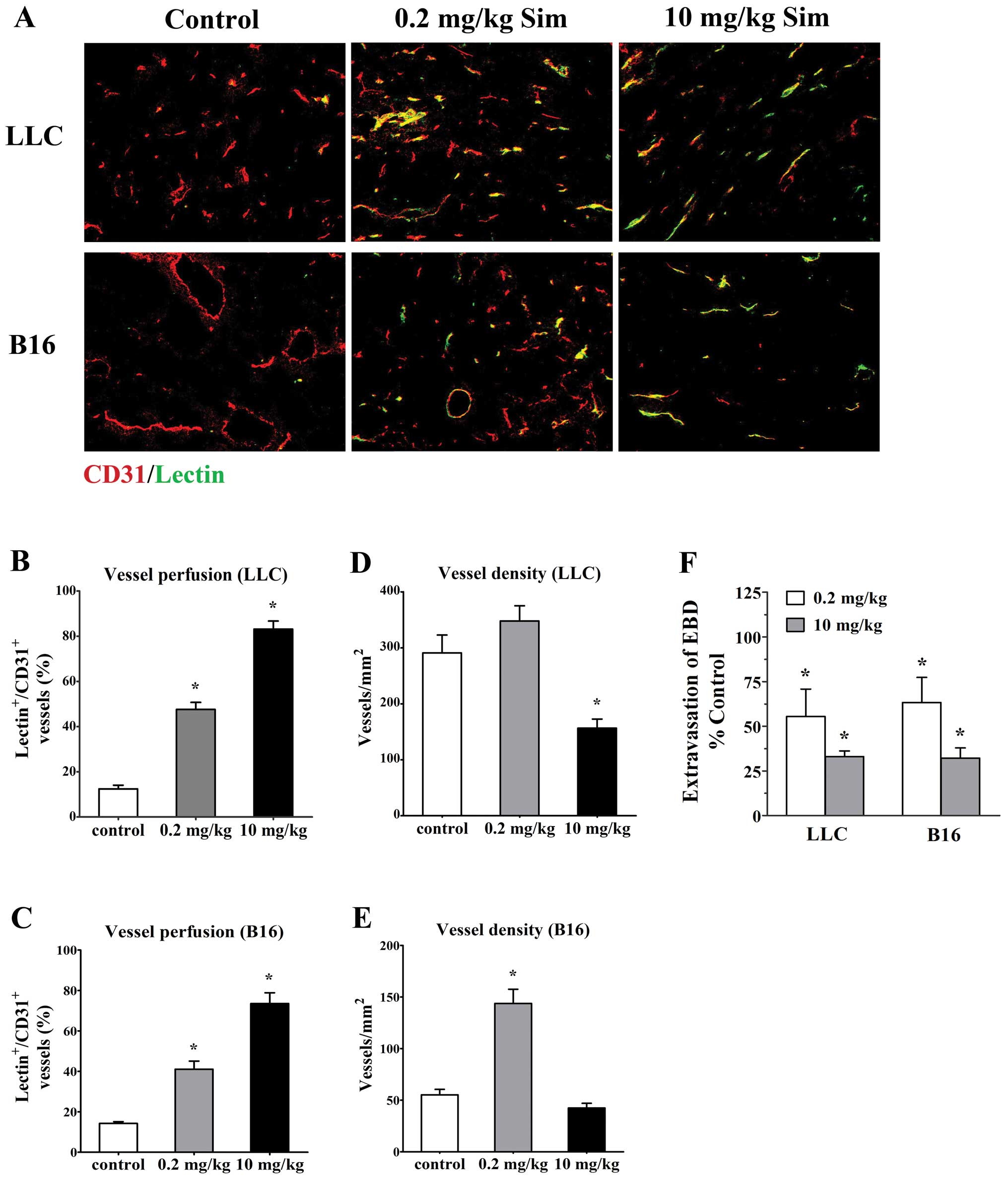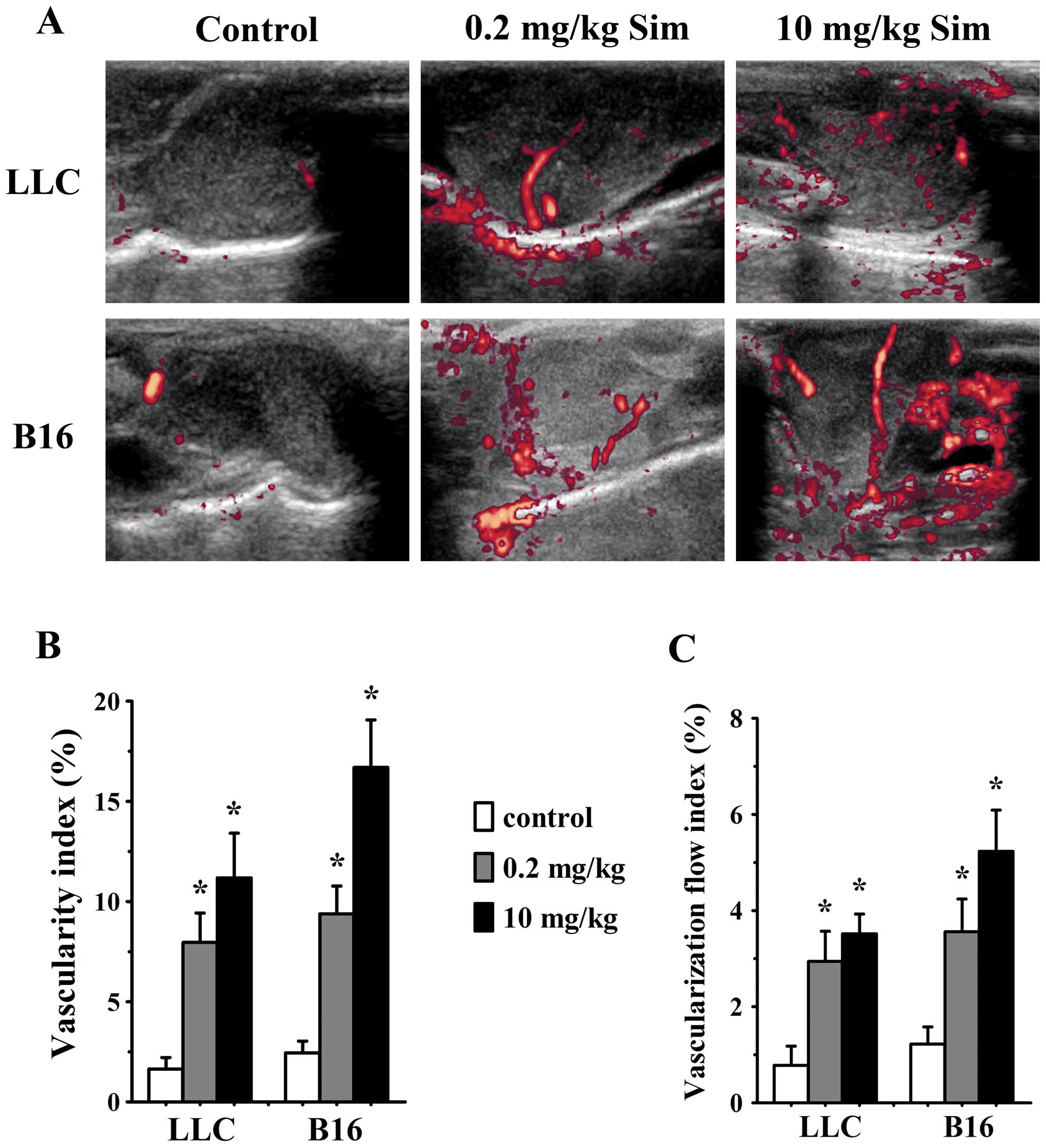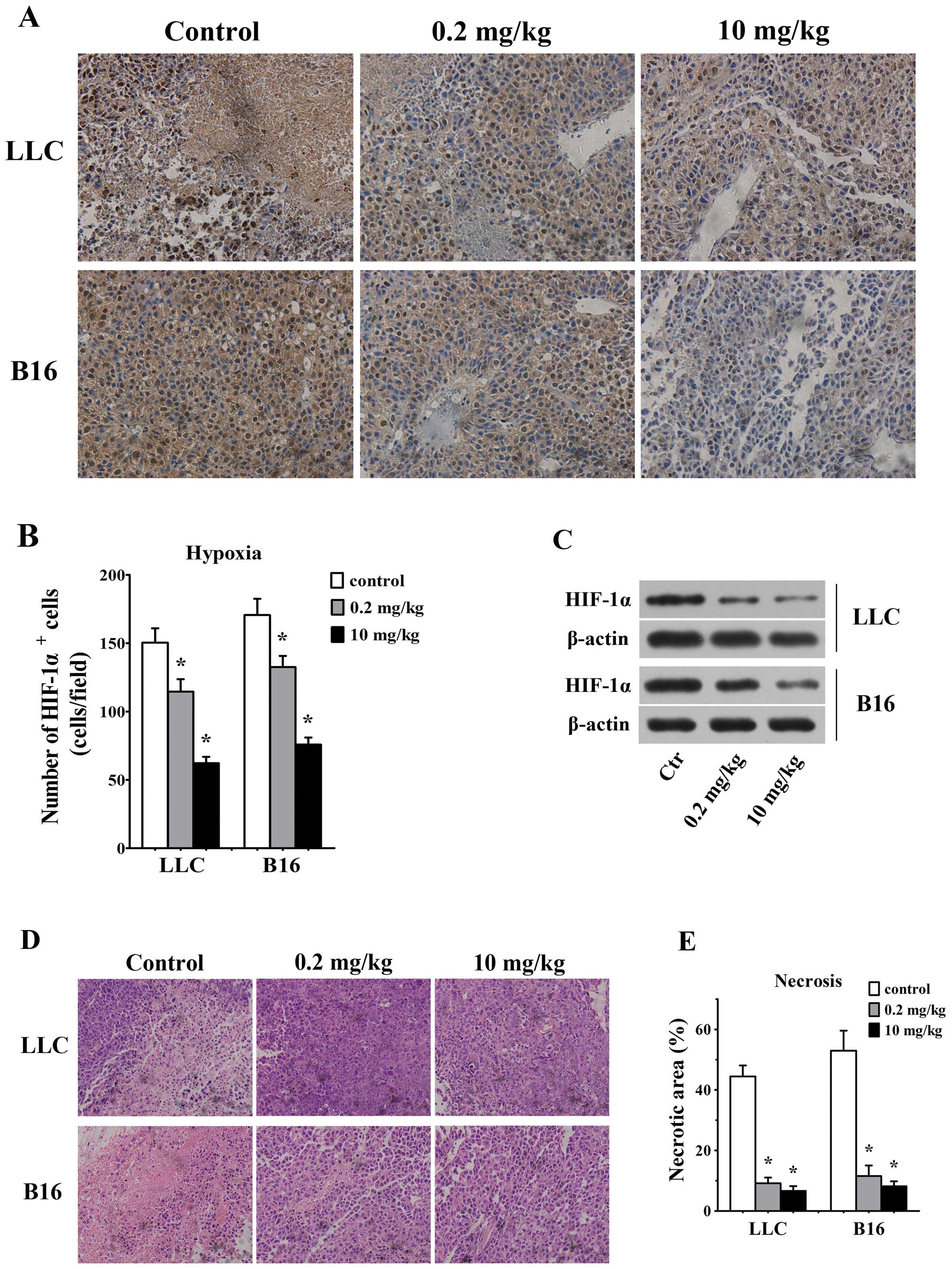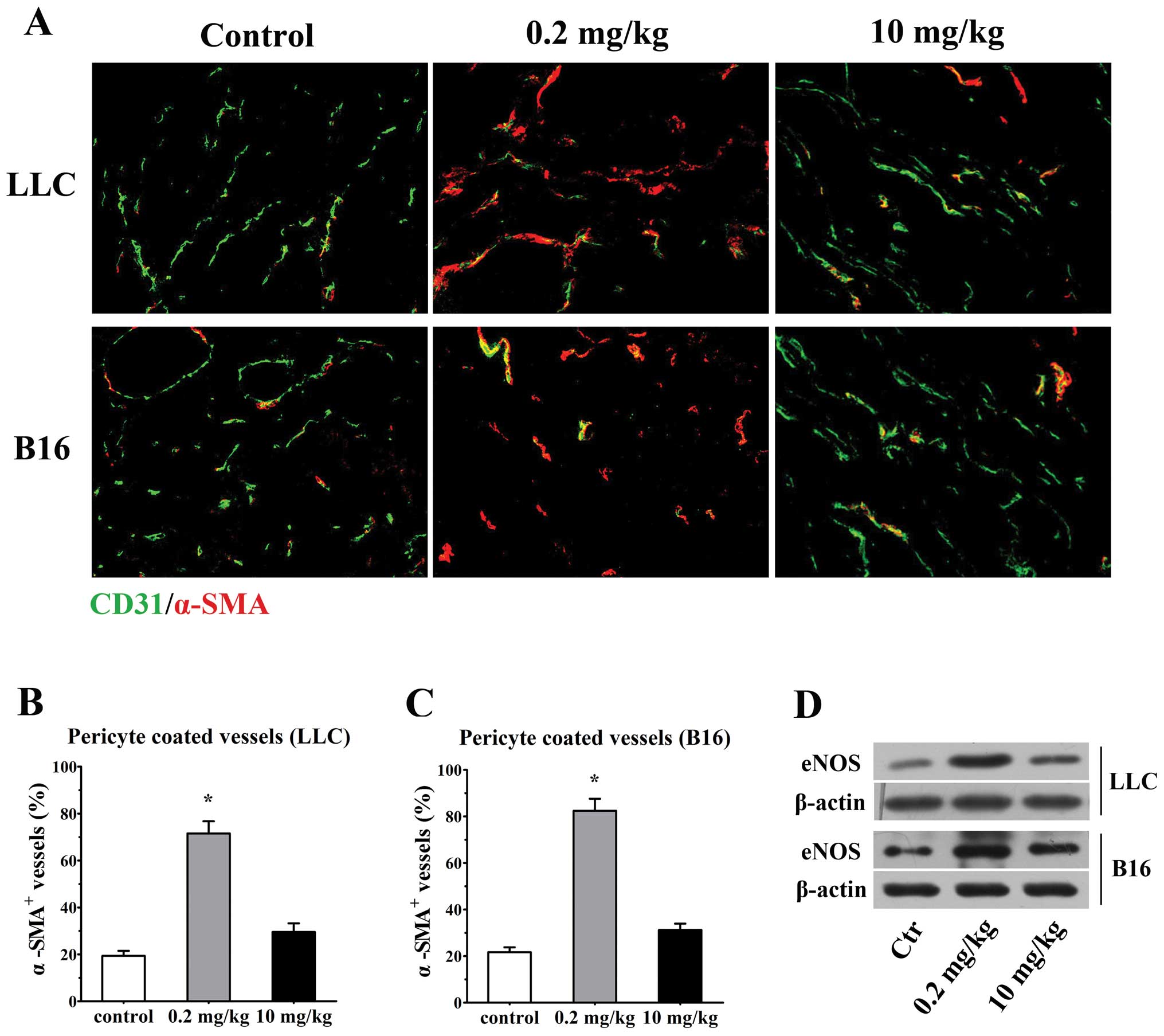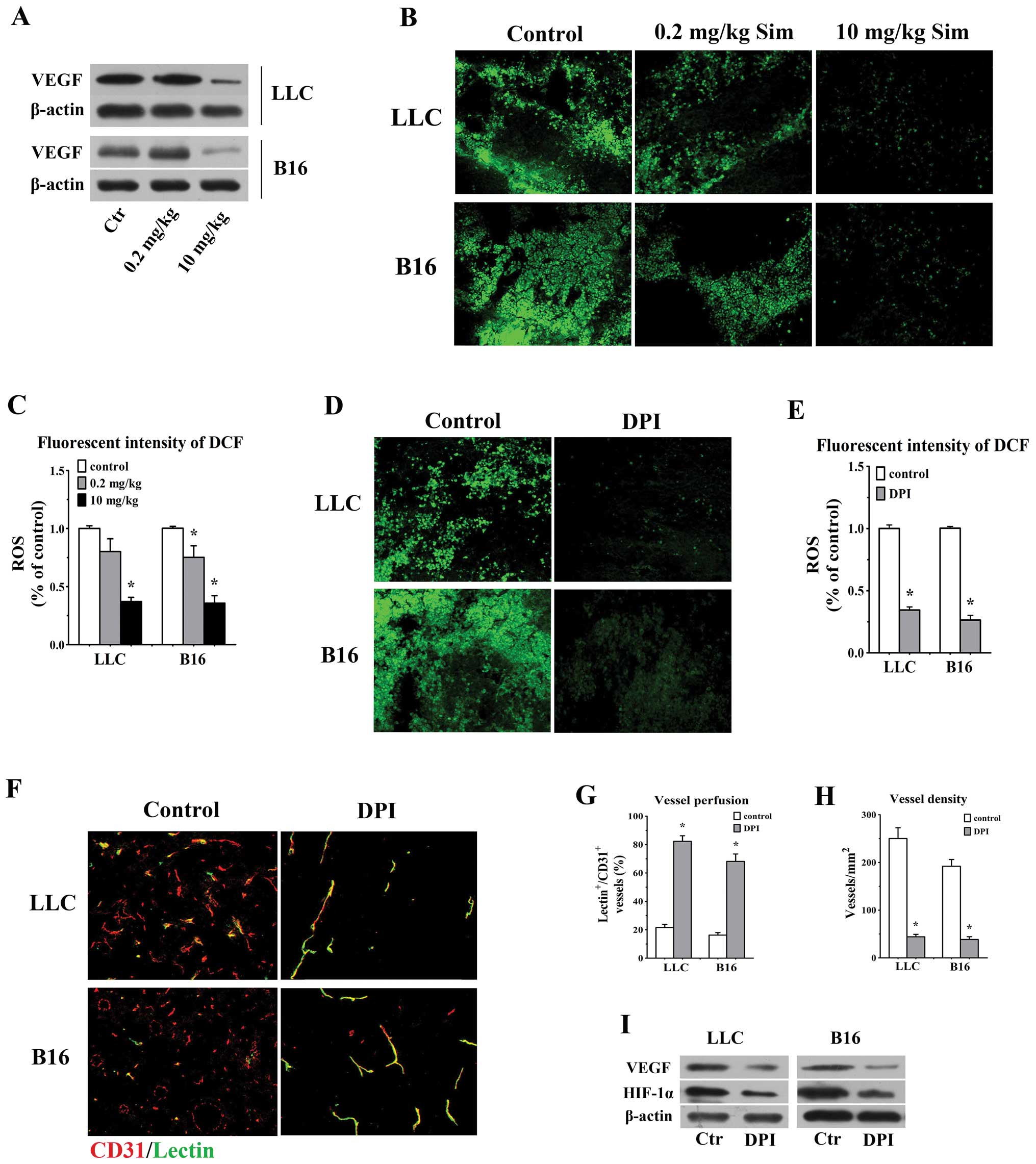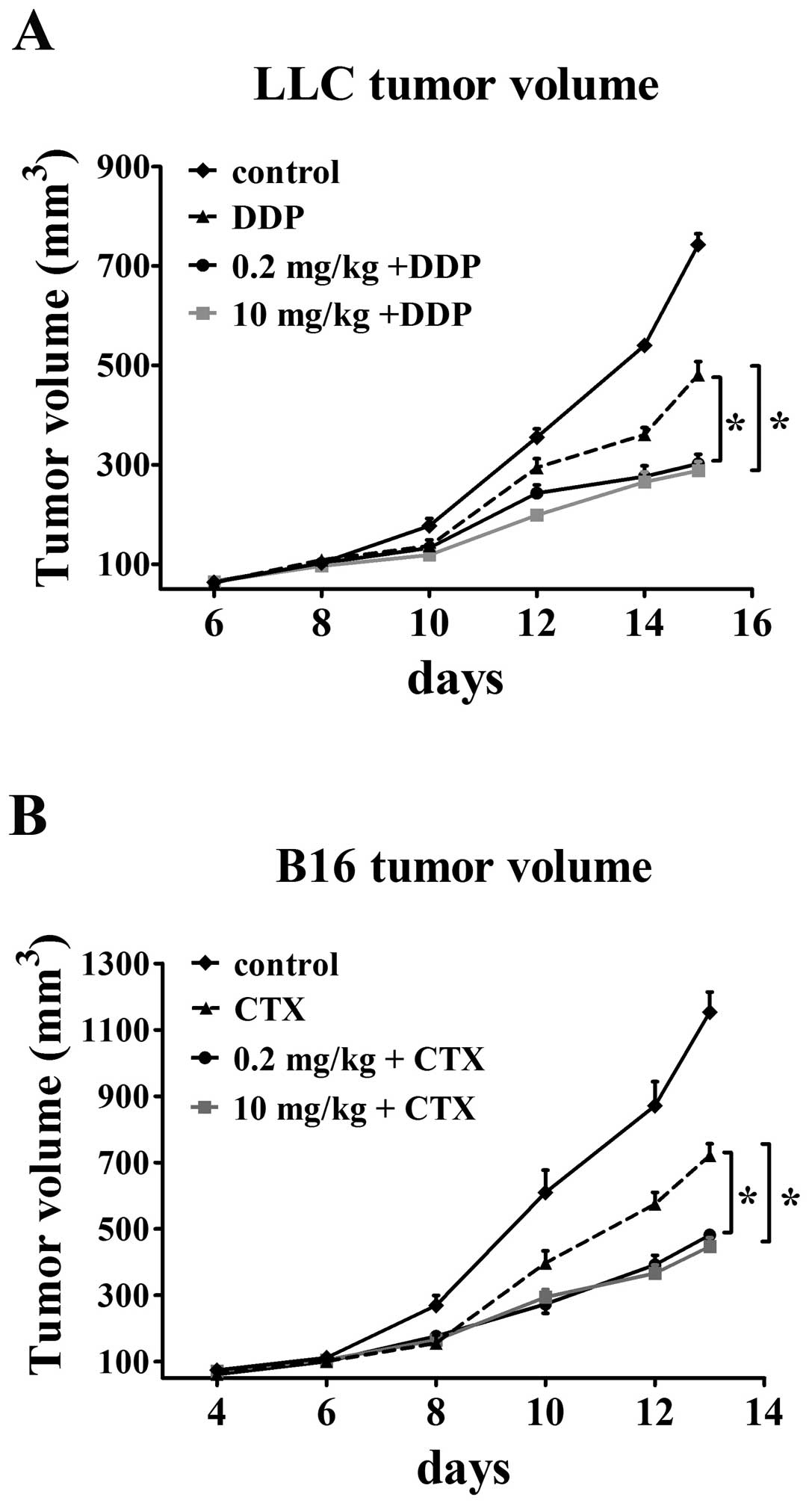|
1
|
Carmeliet P and Jain RK: Principles and
mechanisms of vessel normalization for cancer and other angiogenic
diseases. Nat Rev Drug Discov. 10:417–427. 2011. View Article : Google Scholar : PubMed/NCBI
|
|
2
|
Crawford TN, Alfaro DV III, Kerrison JB
and Jablon EP: Diabetic retinopathy and angiogenesis. Curr Diabetes
Rev. 5:8–13. 2009. View Article : Google Scholar
|
|
3
|
Fukumura D, Duda DG, Munn LL and Jain RK:
Tumor micro-vasculature and microenvironment: novel insights
through intravital imaging in pre-clinical models.
Microcirculation. 17:206–225. 2010. View Article : Google Scholar : PubMed/NCBI
|
|
4
|
Hamzah J, Jugold M, Kiessling F, Rigby P,
Manzur M, Marti HH, Rabie T, Kaden S, Gröne HJ, Hämmerling GJ,
Arnold B and Ganss R: Vascular normalization in Rgs5-deficient
tumors promotes immune destruction. Nature. 453:410–414. 2008.
View Article : Google Scholar : PubMed/NCBI
|
|
5
|
De La Cruz JP, Gonzalez-Correa JA,
Guerrero A and de la Cuesta FS: Pharmacological approach to
diabetic retinopathy. Diabetes Metab Res Rev. 20:91–113. 2004.
|
|
6
|
Feng Y, vom Hagen F, Pfister F, Djokic S,
Hoffmann S, Back W, Wagner P, Lin J, Deutsch U and Hammes HP:
Impaired pericyte recruitment and abnormal retinal angiogenesis as
a result of angiopoietin-2 overexpression. Thromb Haemost.
97:99–108. 2007.PubMed/NCBI
|
|
7
|
Durham JT and Herman IM: Microvascular
modifications in diabetic retinopathy. Curr Diab Rep. 11:253–264.
2011. View Article : Google Scholar : PubMed/NCBI
|
|
8
|
Jain RK: Normalizing tumor vasculature
with anti-angiogenic therapy: a new paradigm for combination
therapy. Nat Med. 7:987–989. 2001. View Article : Google Scholar : PubMed/NCBI
|
|
9
|
Mao Y, Kiss S, Boyer JL, Hackett NR, Qiu
J, Carbone A, Mezey JG, Kaminsky SM, D’Amico DJ and Crystal RG:
Persistent suppression of ocular neovascularization with
intravitreal administration of AAVrh.10 coding for bevacizumab. Hum
Gene Ther. 22:1525–1235. 2011. View Article : Google Scholar : PubMed/NCBI
|
|
10
|
Zheng Z, Chen H, Wang H, Ke B, Zheng B, Li
Q, Li P, Su L, Gu Q and Xu X: Improvement of retinal vascular
injury in diabetic rats by statins is associated with the
inhibition of mitochondrial reactive oxygen species pathway
mediated by peroxisome proliferator-activated receptor γ
coactivator 1α. Diabetes. 59:2315–2325. 2010.PubMed/NCBI
|
|
11
|
Li J, Wang JJ, Chen D, Mott R, Yu Q, Ma JX
and Zhang SX: Systemic administration of HMG-CoA reductase
inhibitor protects the blood-retinal barrier and ameliorates
retinal inflammation in type 2 diabetes. Exp Eye Res. 89:71–78.
2009. View Article : Google Scholar : PubMed/NCBI
|
|
12
|
Wong WW, Dimitroulakos J, minden MD and
Penn LZ: HMG-CoA reductase inhibitors and the malignant cell: the
statin family of drugs as triggers of tumor-specific apoptosis.
Leukemia. 16:508–519. 2002. View Article : Google Scholar : PubMed/NCBI
|
|
13
|
Li J, Wang JJ, Yu Q, Chen K, Mahadev K and
Zhang SX: Inhibition of reactive oxygen species by lovastatin
downregulates vascular endothelial growth factor expression and
ameliorates blood-retinal barrier breakdown in db/db mice role of
NADPH oxidase 4. Diabetes. 59:1528–1538. 2010. View Article : Google Scholar
|
|
14
|
Oliveira VN, Bessa A, Jorge ML, Oliveira
RJ, de Mello MT, De Agostini GG, Jorge PT and Espindola FS: The
effect of different training programs on antioxidant status,
oxidative stress and metabolic control in type 2 diabetes. Appl
Physiol Nutr Metab. 37:334–344. 2012. View Article : Google Scholar : PubMed/NCBI
|
|
15
|
Woo DK, Green PD, Santos JH, D’Souza AD,
Walther Z, Martin WD, Christian BE, Chandel NS and Shadel GS:
Mitochondrial genome instability and ROS enhance intestinal
tumorigenesis in APC(Min/+) mice. Am J Pathol. 180:24–31.
2012.PubMed/NCBI
|
|
16
|
Lin RZ, Wang TP, Hung RJ, Chuang YJ, Chien
CC and Chang HY: Tumor-induced endothelial cell apoptosis: roles of
NAD(P)H oxidase-derived reactive oxygen species. J Cell Physiol.
226:1750–1762. 2011. View Article : Google Scholar : PubMed/NCBI
|
|
17
|
Deng B, Xie S, Wang J, Xia Z and Nie R:
Inhibition of protein kinase Cβ2 prevents tumor necrosis
factor-α-induced apoptosis and oxidative stress in endothelial
cells: The role of NADPH oxidase subunits. J Vasc Res. 49:144–159.
2012.
|
|
18
|
Kojima H, Otani A, Oishi A, Makiyama Y,
Nakagawa S and Yoshimura N: Granulocyte colony-stimulating factor
attenuates oxidative stress-induced apoptosis in vascular
endothelial cells and exhibits functional and morphologic
protective effect in oxygen-induced retinopathy. Blood.
117:1091–1100. 2011. View Article : Google Scholar
|
|
19
|
Xia C, Meng Q, Liu LZ, Rojanasakul Y, Wang
XR and Jiang BH: Reactive oxygen species regulate angiogenesis and
tumor growth through vascular endothelial growth factor. Cancer
Res. 67:10823–10830. 2007. View Article : Google Scholar : PubMed/NCBI
|
|
20
|
Weis M, Heeschen C, Glassford AJ and Cooke
JP: Statins have biphasic effects on angiogenesis. Circulation.
105:739–745. 2002. View Article : Google Scholar : PubMed/NCBI
|
|
21
|
Meda C, Plank C, Mykhaylyk O, Schmidt K
and Mayer B: Effects of statins on nitric oxide/cGMP signaling in
human umbilical vein endothelial cells. Pharmacol Rep. 62:100–112.
2010. View Article : Google Scholar : PubMed/NCBI
|
|
22
|
Kashiwagi S, Izumi Y, Gohongi T, Demou ZN,
Xu L, Huang PL, Buerk DG, Munn LL, Jain RK and Fukumura D: NO
mediates mural cell recruitment and vessel morphogenesis in murine
melanomas and tissue-engineered blood vessels. J Clin Invest.
115:1816–1827. 2005. View
Article : Google Scholar : PubMed/NCBI
|
|
23
|
Sadeghi MM, Collinge M, Pardi R and Bender
JR: Simvastatin modulates cytokine-mediated endothelial cell
adhesion molecule induction: involvement of an inhibitory G
protein. J Immunol. 165:2712–2718. 2000. View Article : Google Scholar : PubMed/NCBI
|
|
24
|
Mills EM, Takeda K, Yu ZX, Ferrans V,
Katagiri Y, Jiang H, Lavigne MC, Leto TL and Guroff G: Nerve growth
factor treatment prevents the increase in superoxide produced by
epidermal growth factor in PC12 cells. J Biol Chem.
273:22165–22168. 1998. View Article : Google Scholar : PubMed/NCBI
|
|
25
|
Gerhardt H and Semb H: Pericytes:
gatekeepers in tumour cell metastasis? J Mol Med. 86:135–144. 2008.
View Article : Google Scholar : PubMed/NCBI
|
|
26
|
Chen J, Cui X, Zacharek A and Chopp M:
Increasing Ang1/Tie2 expression by simvastatin treatment induces
vascular stabilization and neuroblast migration after stroke. J
Cell Mol Med. 13:1348–1357. 2009. View Article : Google Scholar : PubMed/NCBI
|
|
27
|
Vincent L, Chen W, Hong L, Mirshahi F,
Mishal Z, Mirshahi-Khorassani T, Vannier JP, Soria J and Soria C:
Inhibition of endothelial cell migration by cerivastatin, an
HMG-CoA reductase inhibitor: contribution to its anti-angiogenic
effect. FEBS Lett. 495:159–166. 2001. View Article : Google Scholar : PubMed/NCBI
|
|
28
|
De Bock K, Cauwenberghs S and Carmeliet P:
Vessel abnormalization: another hallmark of cancer? Molecular
mechanisms and therapeutic implications. Curr Opin Genet Dev.
21:73–79. 2010.PubMed/NCBI
|
|
29
|
Tong RT, Boucher Y, Kozin SV, Winkler F,
Hicklin DJ and Jain RK: Vascular normalization by vascular
endothelial growth factor receptor 2 blockade induces a pressure
gradient across the vasculature and improves drug penetration in
tumors. Cancer Res. 64:3731–3736. 2004. View Article : Google Scholar : PubMed/NCBI
|
|
30
|
Rapisarda A and Melillo G: Role of the
hypoxic tumor micro-environment in the resistance to
anti-angiogenic therapies. Drug Resist Updat. 12:74–80. 2009.
View Article : Google Scholar : PubMed/NCBI
|
|
31
|
Pennacchietti S, Michieli P, Galluzzo M,
Mazzone M, Giordano S and Comoglio PM: Hypoxia promotes invasive
growth by transcriptional activation of the met protooncogene.
Cancer Cell. 3:347–361. 2003. View Article : Google Scholar : PubMed/NCBI
|
|
32
|
Raza A, Franklin MJ and Dudek AZ:
Pericytes and vessel maturation during tumor angiogenesis and
metastasis. Am J Hematol. 85:593–598. 2010. View Article : Google Scholar : PubMed/NCBI
|
|
33
|
Greenberg JI and Cheresh DA: VEGF as an
inhibitor of tumor vessel maturation: implications for cancer
therapy. Expert Opin Biol Ther. 9:1347–1356. 2009. View Article : Google Scholar : PubMed/NCBI
|
|
34
|
Winkler F, Kozin SV, Tong RT, Chae SS,
Booth MF, Garkavtsev I, Xu L, Hicklin DJ, Fukumura D, di Tomaso E,
Munn LL and Jain RK: Kinetics of vascular normalization by VEGFR2
blockade governs brain tumor response to radiation: role of
oxygenation, angiopoietin-1 and matrix metalloproteinases. Cancer
Cell. 6:553–563. 2004.
|
|
35
|
Jadeski LC and Lala PK: Nitric oxide
synthase inhibition by NG-nitro-L-arginine methylester inhibits
tumor-induced angiogenesis in mammary tumors. Am J Pathol.
155:1381–1390. 1999. View Article : Google Scholar : PubMed/NCBI
|
|
36
|
Ozkiris A, Erkiliç K, Koç A and Mistik S:
Effect of atorvastatin on ocular blood flow velocities in patients
with diabetic retinopathy. Br J Ophthalmol. 91:69–73. 2007.
View Article : Google Scholar : PubMed/NCBI
|
|
37
|
Yu J, deMuinck ED, Zhuang Z, Drinane M,
Kauser K, Rubanyi GM, Qian HS, Murata T, Escalante B and Sessa WC:
Endothelial nitric oxide synthase is critical for ischemic
remodeling, mural cell recruitment and blood flow reserve. Proc
Natl Acad Sci USA. 102:10999–11004. 2005. View Article : Google Scholar : PubMed/NCBI
|
|
38
|
Sata M, Nishimatsu H, Osuga J, Tanaka K,
Ishizaka N, Ishibashi S, Hirata Y and Nagai R: Statins augment
collateral growth in response to ischemia but they do not promote
cancer and atherosclerosis. Hypertension. 43:1214–1220. 2004.
View Article : Google Scholar : PubMed/NCBI
|
|
39
|
Wang N, Ko SH, Chai W, Li G, Barrett EJ,
Tao L, Cao W and Liu Z: Resveratrol recruits rat muscle
microvasculature via a nitric oxide-dependent mechanism that is
blocked by TNFα. Am J Physiol Endocrinol Metab. 300:E195–E201.
2011.PubMed/NCBI
|
|
40
|
Morikawa S, Baluk P, Kaidoh T, Haskell A,
Jain RK and McDonald DM: Abnormalities in pericytes on blood
vessels and endothelial sprouts in tumors. Am J Pathol.
160:985–1000. 2002. View Article : Google Scholar : PubMed/NCBI
|
|
41
|
Tu YT, Tao J, Liu YQ, Li Y, Huang CZ,
Zhang XB and Lin Y: Expression of endothelial nitric oxide synthase
and vascular endothelial growth factor in human malignant melanoma
and their relation to angiogenesis. Clin Exp Dermatol. 31:413–418.
2006. View Article : Google Scholar : PubMed/NCBI
|
|
42
|
Jain RK: Normalization of tumor
vasculature: an emerging concept in antiangiogenic therapy.
Science. 307:58–62. 2005. View Article : Google Scholar : PubMed/NCBI
|
|
43
|
Dickson PV, Hamner JB, Sims TL, Fraga CH,
Ng CY, Rajasekeran S, Hagedorn NL, McCarville MB, Stewart CF and
Davidoff AM: Bevacizumab-induced transient remodeling of the
vasculature in neuroblastoma xenografts results in improved
delivery and efficacy of systemically administered chemotherapy.
Clin Cancer Res. 13:3942–3950. 2007. View Article : Google Scholar
|
|
44
|
Myers AL, Williams RF, Ng CY, Hartwich JE
and Davidoff AM: Bevacizumab-induced tumor vessel remodeling in
rhabdomyosarcoma xenografts increases the effectiveness of adjuvant
ionizing radiation. J Pediatr Surg. 45:1080–1085. 2010. View Article : Google Scholar : PubMed/NCBI
|
|
45
|
Kohno R, Hata Y, Mochizuki Y, Arita R,
Kawahara S, Kita T, Miyazaki M, Hisatomi T, Ikeda Y, Aiello LP and
Ishibashi T: Histopathology of neovascular tissue from eyes with
proliferative diabetic retinopathy after intravitreal bevacizumab
injection. Am J Ophthalmol. 150:223–229. 2010. View Article : Google Scholar
|
|
46
|
Sorensen AG, Emblem KE, Polaskova P,
Jennings D, Kim H, Ancukiewicz M, Wang M, Wen PY, Ivy P, Batchelor
TT and Jain RK: Increased survival of glioblastoma patients who
respond to antiangiogenic therapy with elevated blood perfusion.
Cancer Res. 72:402–407. 2012. View Article : Google Scholar : PubMed/NCBI
|
|
47
|
Sharma RK, Rogojina AT and Chalam KV:
Bevacizumab therapy normalizes the pathological intraocular
environment beyond neutralizing VEGF. Mol Vis. 16:2175–2184.
2010.PubMed/NCBI
|
|
48
|
Gupta A, Gupta V, Thapar S and Bhansali A:
Lipid-lowering drug atorvastatin as an adjunct in the management of
diabetic macular edema. Am J Ophthalmol. 137:675–682.
2004.PubMed/NCBI
|
|
49
|
ten Kate M, van der Wal JB, Sluiter W,
Hofland LJ, Jeekel J, Sonneveld P and van Eijck CH: The role of
superoxide anions in the development of distant tumour recurrence.
Br J Cancer. 95:1497–1503. 2006.PubMed/NCBI
|
|
50
|
Wang C, Tao W, Wang Y, Bikow J, Lu B,
Keating A, Verma S, Parker TG, Han R and Wen XY: Rosuvastatin,
identified from a zebrafish chemical genetic screen for
antiangiogenic compounds, suppresses the growth of prostate cancer.
Eur Urol. 58:418–426. 2010. View Article : Google Scholar : PubMed/NCBI
|
|
51
|
Mandal CC and Ghosh-Choudhury N, Yoneda T,
Choudhury GG and Ghosh-Choudhury N: Simvastatin prevents skeletal
metastasis of breast cancer by an antagonistic interplay between
p53 and CD44. J Biol Chem. 286:11314–11327. 2011. View Article : Google Scholar : PubMed/NCBI
|















